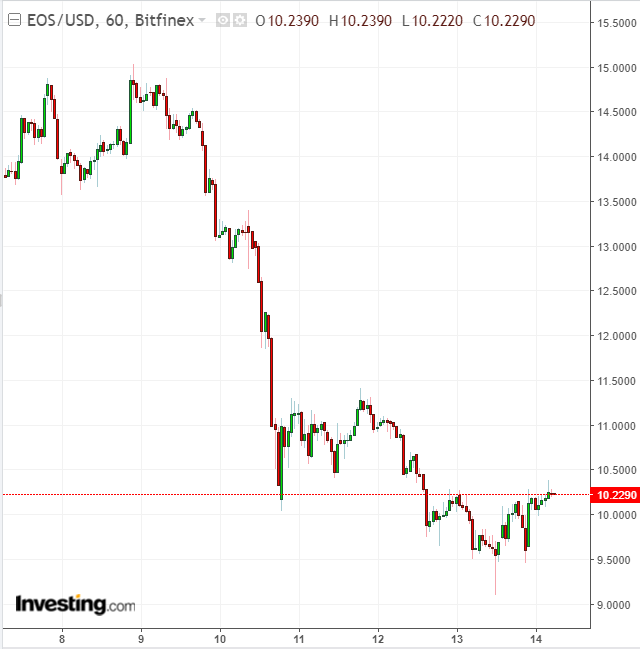The highly anticipated EOS mainnet launch that was at first scheduled for June 2, then pushed to June 10 has now officially stalled, leaving EOS tokens in limbo. The alt-coin created by Block.one, a Cayman Islands-based company and released mid-2017, currently exists on the Ethereum platform; the launch will allow it to move to its own main network.
The standstill, described by many as chaotic, is a result of the complexity of the process which requires existing token holders to vote to elect 21 EOS block producers (BPs) who would essentially mine the currency. But the voting process requires a minimum 15% of voter weigh-in before anything can go forward. Currently only 9.9% of EOS account holders have voted.
Though Block.one released version 1.0 of the EOS software, thereby technically launching the mainnet, without approval from 15% of its stakeholders, EOS is not officially live, leaving the alt-currency vulnerable to attack. EOS tokens are now frozen, as voting continues.

The digital currency is currently the fifth largest cryptocurrency by market cap. Its price has plummeted over the past week. Down 24.79% at time of writing.
Vulnerable and Open to Attack
When transiting blockchains there are a number of security risks at play. In this particular case, a critical risk is low number of block producers (21), which could open the way for an attack. While node security risks are not unique to EOS, when a system only has 21 centralized nodes, the network is, by its very nature, more susceptible to manipulation. Brendan Playford, CEO of Constellation points out that the EOS model sacrifices the dream of decentralization at the altar of scalability.
The small number of producers is a blatant concern. “I understand from various sources that the main plan was that 21 block producers are to be appointed," says Roni Baibochaev, founder of CryptoXchange. That's highly risky he explains, and increases the possibility of a 51% attack. On the other hand, he says, "it does make sense to minimize the risk of having too many BPs which might slow scalability. The EOS team will sooner or later have to decide if it’s worth the risk."
But Baibochaev doesn't see any of this as deep rooted or unsolvable:
“The main question is whether the challenges that EOS is now facing are temporary and if they can be avoided, so they're not long-lasting. True, the main network launch didn’t go according to plan. Hence EOS has to make sure that it will achieve its goals on a longer term perspective.”
Lack of Transparency Adds to Complexity
Estefano Elhawary co-founder of Block Stocks sees additional risks, some having to do with lack of transparency rather than technological issues that come with transiting blockchains, in this case EOS migrating off Ethereum. Since such a small number of EOS holders have thus far voted for block producers, Elhawary sees this as a failure on the part of EOS for not stressing the vote's importance, which would have provided a better user experience.
“The problem is the sheer amount of education required: from explaining why EOS is currently on Ethereum’s chain but moving to a new one, to showing users how to register their new tokens (across a variety of different channels), to integrating with exchanges to be able to support the swap, to getting users to interact on the new chain, etc. It’s a lot of information to digest and communicate for a topic that has a lot of complexity.”
It makes you wonder how EOS was able to raise $4B in their ICO, notes Elhawary, yet they couldn’t muster up a $10-100K budget in order to facilitate the stakeholder vote.
Learning From Past Failures
The crypto industry has seen many great initiatives fail early on, says Mati Greenspan, senior market analyst at eToro, often due to fatal security flaws. This includes the very first initial coin offering which was known as the DAO project, which raised $150 million. But in mid-2016 a hacker discovered a loophole in the code, which allowed him to siphon off about $70 million worth of Ethereum, which at that time amounted to 3.6 million tokens.
“EOS is a bit more centralized, both in token distribution and in governance," points out Greenspan, "and it's very well funded. All of which should help the team get to a stable launch eventually. As an investor, I'm not worried about any short-term delay and understand that they're doing the best to get this massive project off the ground as smoothly as possible.”
Greenspan compares the EOS stall to an airplane as it's about to take-off.
"Imagine you're on a plane before takeoff and the captain comes on the PA system to inform you there are some technical difficulties. The reaction from most rational passengers is actually one of relief as it is clear the professionals have identified the issue and will not take off without being absolutely certain it's fixed. In this case, the passengers are being asked to vote on who should be the pilot and crew in a new high tech system that is neither user-friendly nor proven to be secure. So the voting process may take some additional time to work out as well.”
Nicolas Gilot, co-CEO of blockchain-powered gaming distribution platform Ultra, agrees there are positives despite Block.one facing difficulties with the launch of EOS. Unlike many he compliments the open source blockchain protocol developer, calling its handling of EOS “refreshing and promising” because the communication between chains could be a big improvement for scalability. In Gilot's view the fact that EOS will have 21 block producers is part of what make this blockchain unique.
